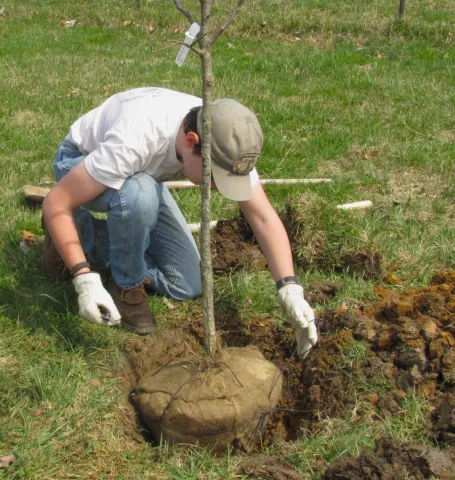Planting Balled Trees

Taking the trouble to plant a tree right greatly improves its chances to survive and grow into a handsome tree.
By Steve Roark
Volunteer, Cumberland Gap National Historical Park
Back in the day planting balled trees or trees grown in buckets was pretty straightforward: Dig a hole wider and deeper than the root ball, mix peat moss or other soil amendment with the soil and plant the tree. But some research has resulted in more stringent guidelines for urban trees. The new recommendations assure that roots have a chance to grow into the surrounding soil and produce healthy branches, foliage, and roots. Here’s an overview.
After selecting a suitable location, mark out a planting hole at least twice the diameter of the root ball. The hole depth should allow the ball to sit on solid ground rather than loose soil and be deep enough so that the top of the ball is level with the existing soil line. After the tree is in place, cut and remove the rope or wire holding the burlap in place. Use a rototiller or shovel to loosen and mix the soil prior to backfilling. It is best not to amend the fill soil unless it is very poor dirt. Backfill around the root area and gently pack to remove major air pockets. Rake the soil evenly over the entire area and cover it with 2-4 inches of mulch. It is best not to stake the tree, but if wind is a problem, support with a flexible stake so the trunk can sway in the wind. This movement helps in building up the trunks' strength.
These new planting recommendations are the result of a study on why the heath of city trees is declining. It was discovered that planting methods were a major reason. Because of heavier equipment being used during home construction and grading, the soil in the average yard is less fertile and more compacted. Digging a hole (the old way) in dense, compacted soil and filling it with peat moss or other amendments creates a "pot" of good soil that the roots refuse to leave. When they reach the original soil, outward growth stops. Instead of spreading into the yard, the roots encircle the planting hole, eventually fill it, and the health of the tree declines.
The new recommendations mean a little more work, but considering the longevity of a healthy tree and the aesthetic and monetary value it adds to your home, it's worth it.
- Log in to post comments